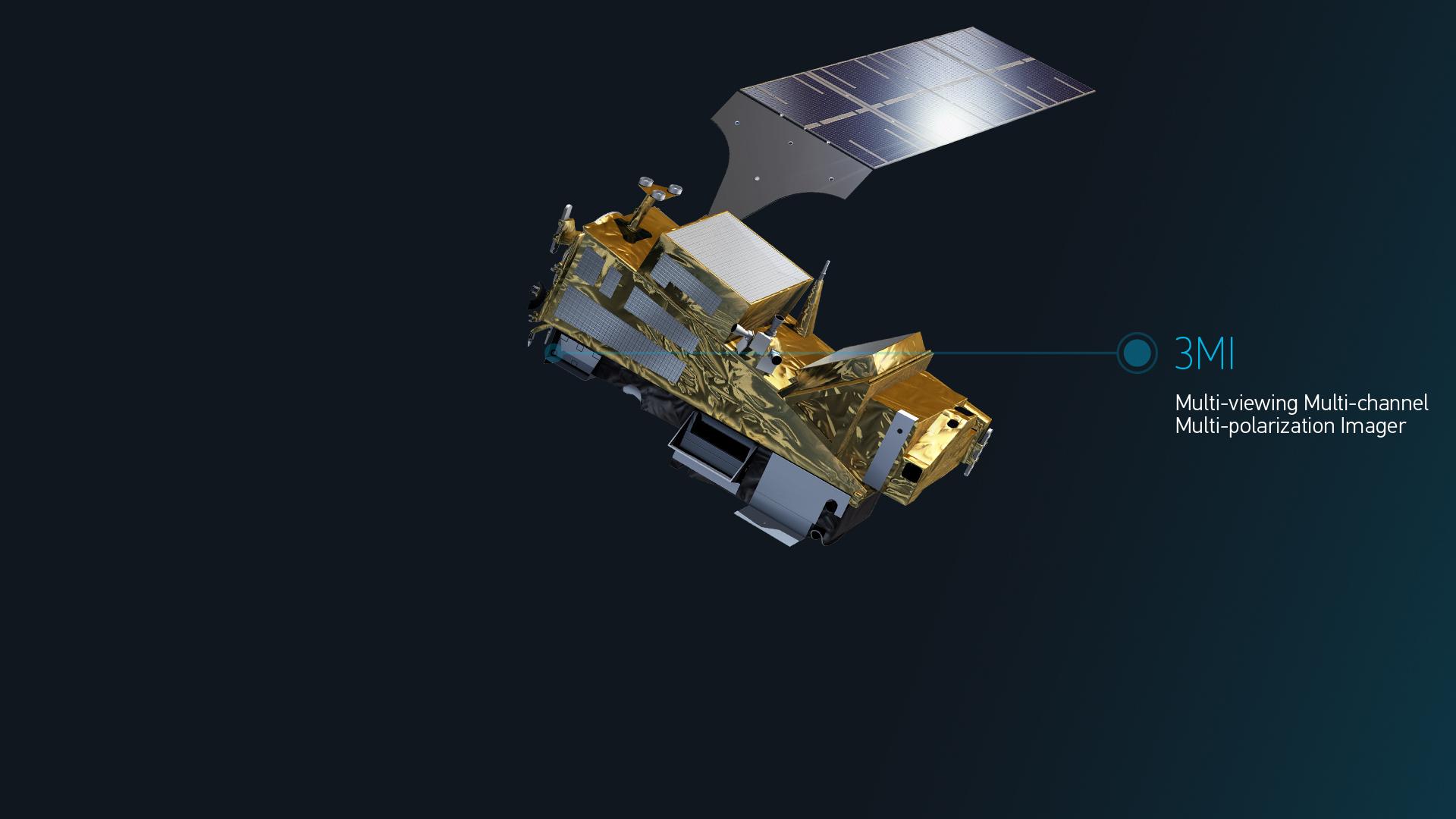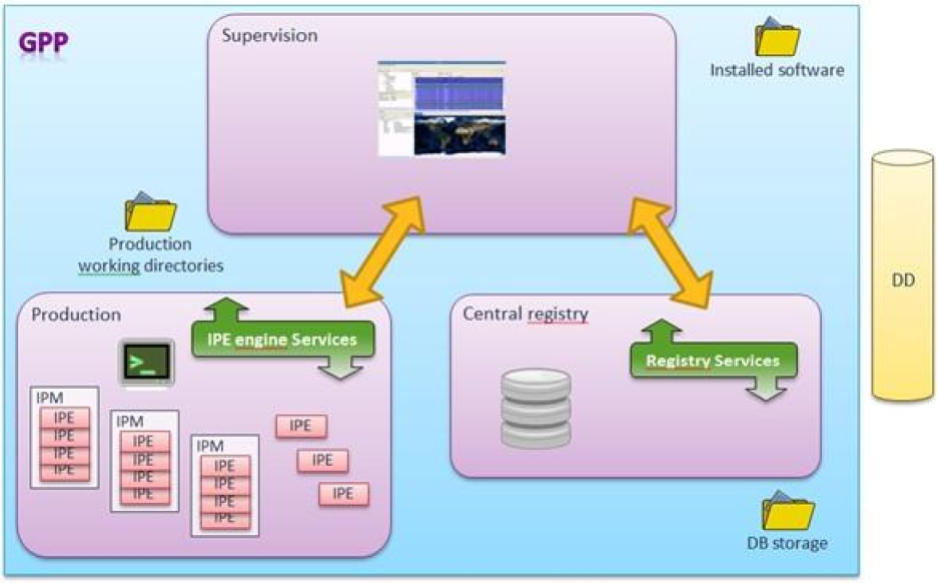3MI
3MI (Multi-acquisition Multi-spectral Band and Multi-polarization) is an imaging instrument of Metop-SG A

Mission
On Ground Calibration (OGC), définition des algorithmes de traitements des données instrument 3MI (ATBD),
Conception et développement de l’IDS (Instrument Data Simulator) permettant la production des données simulées de niveau 0,
Conception et développement des prototypes GPPs de traitements des données 3MI permettant la génération des produits de niveau 1 et intermédiaire,
Conception et développement du PAT (Performance Assessment Tool).
Satellites / Instruments
Metop-SG A satellite with 6 instruments including 3MI
Skills
Prototyping, simulation, C++ language, L0/L1B1/L1B processing, calibration
Date
From 2016 to today
The Metop-SG A and Metop-SG B satellites
The EPS-SG (EUMETSAT Polar System – Second Generation) programme consists of two satellites: Metop-SG A and Metop-SG B. The objective of this programme is to provide continuity of low earth orbit satellite observations for operational meteorology, oceanography, atmospheric chemistry and climate monitoring. Thus, it will meet the needs of users during the period from 2020 to 2040.
Metop-SG A and Metop-SG B operate in the same orbit and have different configurations. The benefits or applications of this mission are focused on weather forecasting, climate change, air quality (atmospheric composition), hydrology, oceanography, etc.
More general information on the 3MI mission can be found on the EUMETSAT website.

Illustration of METOP-SG A satellite
© EUMETSAT
The OGC software
The 3MI instrument is under the responsibility of Leonardo, based in Florence (Italy), which is in charge of the design and implementation of the H/W and SW instruments. CSL is the Leonardo subcontractor for the calibration of the 3MI instrument. It will be launched on the A-satellite platform of the global METOP-SG programme, which will be operated by EUMETSAT.
Magellium’s Earth Observation unit is CSL’s subcontractor. It is in charge of the implementation of the 3MI On Ground Calibration (OGC) software and the generation and maintenance of the 3MI ATBD (instrument data processing algorithms).
The 3MI OGC software consists of 3 main components:
• IMOD/CMOD implements the Instrument Model and the Inverted Calibration Model:
⇒ IMOD simulates the behaviour of the instrument taking into account Spatial and Spectral filtering, and the different radiometric artefacts such as Dark Current, Non-Linearity, Flat-Field, Straylight, etc…IMOD covers the same functional scope as the L0 processing in IDS
⇒ CMOD implements the necessary corrections to compensate for instrument artefacts. CMOD covers the same functional scope as L1B1 processing and RIM processing within GPP.
• ICCDB, implemented in NetCDF format, and containing all Key Data Parameters (KDP) used by both 3MI IDS&GPP and 3MI OGC SW.
Linked to ICCDB, the dedicated software allows to simulate a synthetic version of ICCDB for testing purposes.
• KDPM implements the calculation of all KDPs from the measurements acquired during the calibration campaigns. It also includes dedicated software to allow the simulation of measurements.
![]()
3MI IDS and GPP L1B1 project
The context
Magellium’s Earth Observation unit is the subcontractor to Leonardo for 3MI IDS (instrument data simulation) & GPP SW (prototype processing chain to generate products up to L1B1 level).
The 3MI IDS is to be used to replace the current 3MI instrument flight models until its delivery and integration. In the meantime, this should allow the validation of the L1B1 GPP with simulated data.
The 3MI GPP L1B1 is intended to provide a prototype L1B1 processing chain. This processing chain should then be used by EUMETSAT as a reference chain for the operational production chain (PDAP) within the METOP-SG ground segment.
Finally, the 3MI IDS & GPP L1B1 project is currently in its final phase (SRR delivery in 2016, PDR, TRR and V1 in 2017, V2 delivery in 2018, intermediate versions in 2019/2020/2021), taking into account the results of the EM calibration campaign.
The mission
The 3MI GPP L1B1 software consists of three main components:
• IDS, the 3MI instrument simulator, generating :
⇒ L0 data (Image, Ancillary, NAVATT) in NetCDF4 format and CCSDS format for GPP purposes, simulating future EGSE outputs (3MI and satellite level),
⇒ intermediate data L0 and simulated luminance for validation purposes taken into account by the PAT (Performance Analysis Tool),
• GPP, the 3MI L1B1 correction processing, taking as input :
⇒ CCSDS stream file from IDS or EGSE,
⇒ Product L0 (CCSDS packets encapsulated in NetCDF4 format) from IOV, and generating:
→ Product L0,
→ L1B1 product (to be provided as the main input to the 3MI GPP L1B1/L1B),
→ L1B1 ground radiation and intermediate data for validation purposes taken into account by PAT,
• PAT, used to jointly validate IDS and GPP outputs.
GPP 3MI L1B1/L1B processing
Magellium’s Earth Observation unit is a subcontractor of CNES for the prototyping of the processing chain from level L1b1 to level L1B.

The L1b1/L1b processing calculates the Stokes vectors from L1b1 products in the acquisition sensor reference frame. In a first step, the 3 acquisitions, corresponding to the 3 polarisations under which the same spectral band and the same scene were acquired, are co-registered. Then, in a second step, their radiometric model is inverted in order to calculate the Stokes vector. For unpolarised bands, the processing is based on the Stokes parameters of the neighbouring polarised spectral bands.
![]()
Consortium
EUMETSAT, ESA, Leonardo, CSL, CNES
Key words
observation, satellite, earth, ground segment, 3MI, Metop, EUMETSAT, calibration, c++, prototype, L1B1 processing, ground segment
SCIENCE FOR EARTH CARE
The Earth Observation Unit of Magellium is an expert in optical space missions and geophysical and biophysical applications. The EO unit provides high level of expertise and full capacity on the whole processing chain, enabling it to respond to all projects from the greatest space orders such as ESA and CNES.

